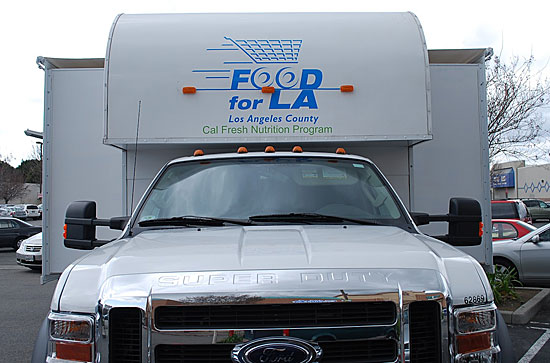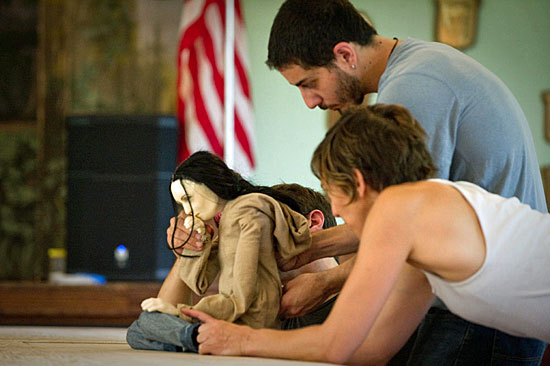Government for the people
July 24, 2013

The CalFresh mobile unit takes the food assistance program on the road for Government Day on Saturday.
This Saturday, you can come home from the mall with more than just a new pair of jeans.
The Panorama Mall is hosting the Northeast San Fernando Valley’s annual Government Day, sponsored by Supervisor Zev Yaroslavsky, on Saturday, July 27. Representatives from dozens of state, city and county agencies will be on hand to answer questions and provide information about services they provide. Looking to adopt a pet? Find out how from the Department of Animal Care and Control. Want to learn more about food assistance? The CalFresh Mobile Unit will be there to screen and register applicants. The event takes place from 10 a.m. to 2 p.m. throughout the mall, which is located at 8401 Van Nuys Boulevard in Panorama City.
Posted 7/24/13
A blueprint for healthy living
February 5, 2013
On Tuesday, the Board of Supervisors adopted a new Healthy Design Ordinance that will change zoning and permitting requirements to promote walking, bicycling, community gardens, farmers’ markets and other elements of good health in future Los Angeles County developments.
Aimed at curbing the epidemic of obesity, diabetes and other diseases, the ordinance is the result of an expanding partnership between planning and public health officials to tilt this car-bound and fast-food-laden metropolis toward a more wholesome scale.
Among other things, the ordinance will require sidewalks in new developments to be shadier, wider and more walkable. It will also mandate bike parking in new projects and make it easier for communities to create community gardens and farmers’ markets, which will be required to accept CalFresh payments, formerly known as food stamps.
For more on the impact of the new rules, click here, and for the text of the ordinance, click here.
Posted 2/5/13
Here’s government for the people
July 17, 2012

The CalFresh Mobile Unit will be at Government Day, along with representatives from 39 other agencies.
People don’t always have time to research everything their government does. For example, only half of the Los Angeles County families that qualify for CalFresh food stamps are actually enrolled in the program. This Saturday in the northeast San Fernando Valley, Government Day will give residents a chance to learn what’s out there—and how to put it to work for themselves and their families.
Representatives from 40 agencies will be on hand, including the Los Angeles County Department of Human Resources, which will have applications for county government jobs; the City of L.A.’s Department of Building and Safety, with information on how to report housing issues; and Access Services, which provides transportation for the disabled. Also participating will be the CalFresh Mobile Unit, offering applications for food assistance; the City of L.A.’s Bureau of Street Services, with tips on how to report potholes and other road or sidewalk problems; and the Northeast San Fernando Worksource Center, which will provide applications for its job training programs.
Government Day has been held annually for the past 31 years. This year’s event takes place on Saturday, July 21, from 10 a.m. to 2 p.m. inside the Panorama Mall at 8401 Van Nuys Boulevard.
Posted 7/17/12
Looking for a snail mail alternative
March 6, 2012

Just a few of the million-plus pieces of mail that the DPSS must, under federal regulations, mail to itself each year.
It may sound like a bureaucratic absurdity straight out of Dilbert: Los Angeles County’s Department of Public Social Services is paying hundreds of thousands of dollars to send itself more than a million pieces of mail each year.
But the reality is no laughing matter.
Federal regulations require the department to communicate with all recipients of CalFresh benefits (formerly known as food stamps) by means of paper mail.
Many homeless recipients list the department’s address as their own so that they may receive benefits. But often, they pick up their mail irregularly, if at all. And that has created mail backlogs and service delays at DPSS offices. The department estimates it spent at least $390,000 on such mailings last year.
So this week, the Board of Supervisors, acting on a motion by Supervisor Don Knabe, directed the Chief Executive Office and DPSS to explore whether there’s a legislative way around the regulations. The motion did not specify a timeframe for coming up with such a strategy.
If allowed to do so, DPSS proposes changing to a system in which people using the department’s address would receive electronic mail which they could access or have printed out for them at DPSS offices.
But altering the system could have some unintended consequences. Christine Khalili-Borna of the Public Counsel Law Center said creating email accounts could raise privacy concerns and might also make it harder for other county agencies, including Public Health, to reach homeless clients.
“This proposed motion might be a good option for those individuals who have the skills, ability and access to email,” Khalili-Borna said. “However, a large number of homeless participants—especially the most vulnerable, including those with mental health, developmental and literacy issues—do not have the skills or means necessary to access this crucial information.”
She said her organization would be willing to work with the county as it explores ways to change the current system. Her offer was accepted.
Posted 3/6/12
All the table’s a stage
January 31, 2012
Matchbox cars, puppets and tiny TVs star in a micro-play about a very big issue—hunger. “Dan Froot & Dan Hurlin: Who’s Hungry–Santa Monica” presents reality for those who have to choose between food and other necessities of life.
The play is staged on a 24-foot dinner table, with the audience seated on one side. Five very different real life “courses” are served in 15- to 20-minute segments, each one telling the history of a different Santa Monica homeless person.
There may be no better time to consider the problem of hunger in our own neighborhoods. In 2008, an estimated 17 million U.S. homes were deemed “food insecure” at some point, an increase of 4 million from the previous year. That rate remained statistically steady through 2010.
One way to fight hunger is with CalFresh; visit the Department of Public Social Services’ website to learn more about this benefit, a rebranding of California’s food stamps program.
“Who’s Hungry–Santa Monica” is presented by Highways, a nonprofit organization dedicated to bringing diverse cultural perspectives to Southern California.
Performances will take place at 8:30 p.m. on Friday, Feb. 3, and at 5 p.m. and 8:30 p.m. on Saturday, Feb. 4. Tickets to the tabletop play are $20 for adults and $15 for students, seniors and members. Highways’ performance space is at 1651 18th Street in Santa Monica.
Posted 1/31/12
Building healthier communities
January 24, 2012

A new ordinance means bike parking must be a part of new developments in unincorporated L.A. County.
What does the width of your sidewalk have to do with the diameter of your waistline?
What do shade trees have to do with how active you are?
And what does bicycle parking have in common with farmers markets and community gardens?
They’re all elements in Los Angeles County’s new Healthy Design Ordinance, initially approved by the Board of Supervisors Tuesday, and now receiving finishing touches from county attorneys.
The ordinance, expected to become law in March, represents part of a new and increasingly important partnership between planners and public health officials trying to fight an epidemic of obesity, diabetes and other diseases by making it easier for people to adopt a more active lifestyle.
To the delight of bicycle advocates, the new ordinance would require for the first time that bike parking be included in new developments in unincorporated parts of Los Angeles County. (Similar provisions are included the county’s proposed Bicycle Master Plan, which is expected to come before the board in coming weeks.)
To foster more walkable communities, the Healthy Design Ordinance also would mandate 5-foot wide sidewalks instead of the current 4-foot standard. And, to make sure those wider sidewalks are inviting, it would require that shade trees be included in future development plans.
It also seeks to bring healthy vegetables and fruits to so-called food deserts by making it easier for farmers markets and community gardens to take root in residential and other areas without a lot of red tape. And written into the ordinance is a requirement that those markets accept CalFresh payments.
Dr. Jonathan E. Fielding, the county’s top public health official, said his department was happy to have invested part of a 2010 grant it received from the federal Centers for Disease Control and Prevention to help get the Healthy Design Ordinance off the ground.
It’s all part of a shift in tactics to move disease prevention out of the doctor’s office and into the streets.
“If we want to improve the health of Angelenos, we need to start by improving our physical environment and our social environment,” Fielding said.
Supervisors praised the work that has been done so far.
“This is a big idea. This is forward-looking. This is progressive policy-making,” said Supervisor Mark Ridley-Thomas.
Board of Supervisors Chairman Zev Yaroslavsky, who initially proposed the measure along with Supervisor Don Knabe, also saluted the efforts. But he said the new ordinance is just a first step toward designing a healthier county.
“Much more needs to be done to create livable neighborhoods that do not rely solely on automobile transportation,” Yaroslavsky said. “County planners and engineers, and private developers, will have to make a concerted effort to achieve neighborhoods where people feel comfortable walking, biking, and taking transit.”
In a motion adopted along with the board’s vote Tuesday in favor of approving the ordinance, Yaroslavsky directed county staff to take a closer look at “zoning and land use policies that encourage sprawling developments which force people to drive vast distances just to get to work, or buy a gallon of milk.”
At the same time, the motion recognized that there are no one-size-fits-all approaches, and that not all healthy design features will apply to every community.
A rethinking of what planning can mean to the health of communities and individuals is “actually pretty exciting,” said Susan Tae, a supervising regional planner who led the Healthy Design team for Regional Planning. “To create a more pleasant environment is to encourage a pedestrian to take a walking trip rather than jump in a car.”
(For a look at some of the guidelines the team came up with in developing the ordinance, click here. And a two-minute summary of the ordinance’s main points is here.)
Tae said other initiatives, such as the upcoming Bicycle Master Plan and a new specific plan to create a more walkable area around Gold Line stations on the 3rd Street Corridor inEast L.A., will help move the spirit of the new ordinance forward.
Designing for health, she said, requires thinking like a walker or cyclist and constantly asking: “How do we create things at more of a pedestrian scale?”
“If it’s not comfortable,” Tae said, “then it’s not going to be used.”
Posted 1/24/12
From typist clerk to the top at DPSS
August 17, 2011
It’s funny how the little things can shape a working life.
Like that summer day in 1967 when Sheryl Spiller, fresh out of Centennial High School, went downtown to the county Hall of Administration with some girlfriends looking for summer jobs.
“I didn’t want to work for the county. But I didn’t want to wait outside either!” So Spiller went inside, aced the test and set off on a county career that has taken her from typist clerk to acting department head.
Spiller is taking the reins of the Department of Public Social Services from Philip Browning, recently named to temporarily head the troubled Department of Children and Family Services.
She’s not sure how long it will last, but it’s all happened so fast that “I don’t have time to fret over it,” she says.
Fretting doesn’t seem to be part of her make-up, in any case.
She’s built her career with a combination of front-line work, strategic savvy and a commitment to helping those around her grow on the job. And with more than three decades of DPSS service under her belt, there’s not much she doesn’t know about the department she’s been chosen to temporarily head.
“Staff jokes about not being able to get stuff by me. I’ve been there, done that,” says Spiller, the agency’s chief deputy director until her temporary appointment this week. Except for 3½ years in the county’s Child Support Services Department, where she first worked with Browning, her entire career has been within DPSS.
Browning calls her “an amazing lady” who’s been generous with her deep knowledge of the department and its people. “I think it’s remarkable that an individual could remain within one organization and have that kind of a presence and an impact,” he says.
“She’s a true, genuine leader,” adds a former boss, Joseph Guerra, now retired as the department’s assistant director. He credits her with a number of innovative contributions, including a pioneering outreach campaign to enroll uninsured children in the Healthy Families program—part of a larger initiative she headed to sign up more than 100,000 kids for Medi-Cal.
Spiller doesn’t foresee any big change of course for DPSS on her watch.
But her own role will be turned inside out.
Accustomed to working behind the scenes, Spiller now will be a more visible presence—front-woman for an agency charged with serving millions of the county’s neediest residents with programs including CalFresh (formerly known as food stamps), in-home services for the elderly and disabled and general relief assistance.
“I’ve always been the person on the inside, always had a focus on our human resources. Philip’s always been the public face of the department…I am going to have to make that shift,” she says.
Ever-shifting career challenges have had a way of turning out well for Spiller. “I would volunteer for everything, wherever the jobs were. I took some of the worst assignments.”
That included a stint at a welfare office then known as the “Unattached Men’s Center” in downtown Los Angeles, where female employees were rare at the time and the district director’s office featured a collection of knives and guns confiscated from the clientele.
“It was a really rough area,” she says. But “I didn’t even think about being afraid.”
She fondly remembers her time working at the DPSS facility nicknamed “The Pink Palace” (the name, and the colorful paint job, have passed into history but the office is still there, at Adams and Grand.) After that, she ran a section charged with coming up with innovations, such as simple, illustrated customer comment cards, that are still in use today. “It gave me an opportunity to be creative,” she says.
Her toughest challenge—although ultimately one of her most rewarding assignments—was going into the Compton office as its district director in the early ‘90s. She had to clean house; among other things, several employees were arrested on drug charges after a sheriff’s surveillance operation. And then there were those bullet holes in her office window—the consequence of being in what was then an active border area for three gangs. Internal Services Division came to the rescue with bullet-resistant glass. “Sheryl, it’s not bullet-proof,” they told her. “But it’ll slow it down.”
Working within a large organization to get things done—like knowing who to call to get those windows fixed quickly—goes along with Spiller’s broader philosophy of networking, educating and mentoring.
Whether setting up an on-premises program for employees in Compton to get their associates’ degrees or working actively with the county’s Management Council to help other managers hone their skills, Spiller says her “personal goal is to leave the department with highly educated, well-trained, success-oriented, self-motivated and healthy employees.”
She’s aware that her own professional narrative is an asset. Her rise from the clerical corps to the top ranks of management reads like a textbook case study, and in fact, a step-by-step account of it appeared in a workforce development publication put out as part of a collaboration between the county and the SEIU local representing many of its workers.
Spiller, 61, still keeps in touch with her old high school principal, who had counseled her to jump on the county track and get her college degree while she worked. (She ended up getting three, including a master’s in human resources and organization development from the University of San Francisco.)
She recently got on the phone to share with him the news of her most recent career move, to acting head of the agency where she’d started as a typist clerk back in ‘67.
“You won’t believe this,” she said, “but remember that advice you gave me 40 years ago? Well, it paid off.”
Posted 8/17/11
Government–up close and personal
July 22, 2011
 All levels of government head to the East San Fernando Valley this Saturday for “Government Day,” a yearly event where government services and information are brought to the public’s doorstep.
All levels of government head to the East San Fernando Valley this Saturday for “Government Day,” a yearly event where government services and information are brought to the public’s doorstep.
L.A. County Supervisor Zev Yaroslavsky is organizing this year’s event, as he has for the last 15 of them.
“We’ve been hosting Government Day for many years out here, and the best part is the chance to meet constituents and introduce them to their government and the public services available to them,” said Yaroslavsky. “I never get tired of that.”
In addition to Yaroslavsky, City Councilmembers Tony Cardenas and Richard Alarcón, State Senator Alex Padilla, and Congressman Howard Berman are also sending their representatives.
Among the more than 40 agencies setting up tables this year:
- Los Angeles County Department of Public Social Services
- Los Angeles County Registrar-Recorder/County Clerk
- Los Angeles County Office of the Assessor
- Los Angeles County Department of Consumer Affairs
- Los Angeles County Department of Human Resources
- Los Angeles Mission Community College
- California State Department of Insurance
- Los Angeles City Department of Building and Safety
Agencies will provide valuable information, giveaways and services. Sign up for CalFresh (formerly Food Stamps), register to vote, and more.
The event takes place Saturday, July 23 from 10 a.m. to 2 p.m. at Panorama Mall, 8401 Van Nuys Boulevard. Get there with the Los Angeles Metropolitan Transit Authority, which will also be in attendance.
Posted 7/22/11
This is how the county rolls
March 6, 2011
 Back in September, the Department of Public Social Services began fighting hunger where it lives by using a mobile unit to help people sign up for food assistance. During the the next few weeks, it’ll be headed into Hollywood and the San Fernando Valley.
Back in September, the Department of Public Social Services began fighting hunger where it lives by using a mobile unit to help people sign up for food assistance. During the the next few weeks, it’ll be headed into Hollywood and the San Fernando Valley.
The Health and Nutrition Mobile Services Unit essentially is a traveling DPSS office, complete with computers and staffers to help with paperwork. Its mission is a crucial one, especially in these challenging economic times.
Only about half of eligible county households currently are enrolled in the CalFresh program, formerly known as food stamps. This means government funds are going untapped and families are going without help to meet their basic nutritional requirements.
The Mobile Services Unit has begun to make a dent in the disparity. It has distributed more than 700 applications, with 430 of them being returned as of last week.
Although its primary work is to bring CalFresh to those who need it, the unit also will offer other services, including help with Medicaid applications. Various community groups are providing the venues for the DPSS truck and supplying their own services.
This month, the Health and Nutrition Mobile Services Unit will be in the Third District at three locations. They are:
Friday, April, 8, from 9 a.m. to 2 p.m.
Los Angeles City College – Mini Resource Event
4311 Melrose Ave., Los Angeles, 90029
Wednesday, April 20 from 9 a.m. to 2 p.m.
Van Nuys Worksource Center – La Mission College
11623 Glenoaks Blvd., Pacoima, 91331
Saturday, April 30 from 9 a.m. to 1 p.m.
Canoga Park Farmers Market & Community Health Fair – at the Community Center
7428 Owensmouth Ave., Canoga Park, 91303
Posted 4/6/11















 405 bridge work causes a stink
405 bridge work causes a stink

